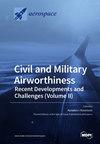The Impact of Upstream Static Deformation on Flow Past a Cylinder/Flare
IF 2.1
3区 工程技术
Q2 ENGINEERING, AEROSPACE
引用次数: 0
Abstract
Reynolds-averaged Navier–Stokes simulations are performed for supersonic turbulent flow over a cylinder/flare with upstream surface distortion representative of structural deformation induced via fluid–structural and fluid–thermal–structural behavior. Broad parametric analysis is carried out through the generation of Kriging-response surfaces from a database of general simulations. A posteriori simulations are then carried out at parametric combinations that correspond to extrema in the Kriging response surfaces to gain deeper insights into the interaction between the surface distortion and flow responses. Upstream distortions tend to decrease, rather than increase, the peak pressure and heat flux loads on the flare compared to an undeformed cylinder. Furthermore, decreases in these quantities reach up to O(10%) compared to up to O(1%) for increases. Integrated quantities over the flare are relatively insensitive to upstream distortion. The corner separation length is the most sensitive quantity to upstream distortion, with protrusions tending to increase the separation length and recessions reducing the separation length. Modifications in the separation length of up to 40% are observed. Reductions in peak loads tend to correspond to increases in the corner separation length. The movement of the surface distortion relative to the corner indicates a negligible impact beyond 1.5 distortion lengths from the corner, and the largest impact on the corner separation length occurs when distortion is directly adjacent. These results are an important step toward understanding and quantifying the impact of surface deformations on downstream components.上游静态变形对流经圆柱体/叶片的影响
对圆柱体/喇叭口上的超音速湍流进行了雷诺平均纳维-斯托克斯模拟,其上游表面变形代表了通过流体-结构和流体-热-结构行为引起的结构变形。通过从一般模拟数据库生成克里金反应曲面,进行广泛的参数分析。然后在与克里金反应曲面极值相对应的参数组合下进行后验模拟,以深入了解曲面变形与流动反应之间的相互作用。与未变形的圆柱体相比,上游变形往往会降低而不是增加扩口上的峰值压力和热通量负荷。此外,这些量的减小可达 O(10%),而增大时则为 O(1%)。扩口上的综合量对上游变形相对不敏感。转角分离长度是对上游变形最敏感的量,突起往往会增加分离长度,而凹陷则会减少分离长度。据观察,分离长度的变化可达 40%。峰值载荷的减少往往与转角分离长度的增加相对应。表面变形相对于转角的移动表明,距离转角 1.5 个变形长度以外的影响可以忽略不计,而当变形直接邻近转角时,对转角分离长度的影响最大。这些结果是了解和量化表面变形对下游部件影响的重要一步。
本文章由计算机程序翻译,如有差异,请以英文原文为准。
求助全文
约1分钟内获得全文
求助全文
来源期刊

Aerospace
ENGINEERING, AEROSPACE-
CiteScore
3.40
自引率
23.10%
发文量
661
审稿时长
6 weeks
期刊介绍:
Aerospace is a multidisciplinary science inviting submissions on, but not limited to, the following subject areas: aerodynamics computational fluid dynamics fluid-structure interaction flight mechanics plasmas research instrumentation test facilities environment material science structural analysis thermophysics and heat transfer thermal-structure interaction aeroacoustics optics electromagnetism and radar propulsion power generation and conversion fuels and propellants combustion multidisciplinary design optimization software engineering data analysis signal and image processing artificial intelligence aerospace vehicles'' operation, control and maintenance risk and reliability human factors human-automation interaction airline operations and management air traffic management airport design meteorology space exploration multi-physics interaction.
 求助内容:
求助内容: 应助结果提醒方式:
应助结果提醒方式:


